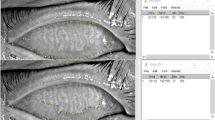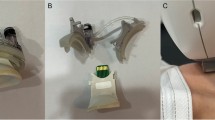Abstract
This study aimed to evaluate the safety and efficacy of a low-level radiofrequency thermal treatment in an obstructive MGD rabbit model. Meibomian gland orifices of the central two-thirds of the upper and lower eyelid margins were coagulated twice at 2-week intervals using a 5-MHz high-frequency electrosurgical unit. Sixteen eyes of eight rabbits were treated with one session of radiofrequency thermal treatment (radiofrequency group) and eight eyes of four rabbits were followed up without treatment (control group). Lid margin abnormality and corneal staining scores, histologic examination of the eyelids and meibombian gland, and meibography imaging were evaluated just before and 4 weeks after meibomian gland orifice closure and 4 weeks after radiofrequency thermal treatment. Lid margin abnormality score improved significantly for the upper and lower eyelids after radiofrequency thermal treatment (P < 0.001 for both eyelids). Corneal staining score remained unchanged in the radiofrequency group; however, the control group saw an increase at final follow-up. There was a significant improvement to almost baseline levels in the mean area of secretory acini in the radiofrequency group (P = 0.004). Additionally, meibography indicated an improvement in meibomian gland loss rate in the radiofrequency group. Low-level radiofrequency thermal treatment heating the inner and outer eyelid surfaces is safe and effective to treat obstructive MGD in a rabbit animal model of MGD.
Graphical abstract





Similar content being viewed by others
Data availability
The data used to support the findings of this study are available from the corresponding author upon request.
Code availability
Not applicable.
References
Craig JP, Nichols KK, Akpek EK, Caffery B, Dua HS, Joo CK et al (2017) TFOS DEWS II definition and classification report. Ocul Surf 15(3):276–283
Lemp MA, Crews LA, Bron AJ, Foulks GN, Sullivan BD (2012) Distribution of aqueous-deficient and evaporative dry eye in a clinic-based patient cohort: a retrospective study. Cornea 31(5):472–478
Nelson JD, Shimazaki J, Benitez-del-Castillo JM, Craig JP, McCulley JP, Den S et al (2011) The international workshop on meibomian gland dysfunction: report of the definition and classification subcommittee. Invest Ophthalmol Vis Sci 52(4):1930–1937
Eom Y, Na KS, Cho KJ, Hwang HS, Kim SW, Chung TY et al (2019) Distribution and characteristics of meibomian gland dysfunction subtypes: a multicenter study in South Korea. Korean J Ophthalmol 33(3):205–213
Shimazaki J, Sakata M, Tsubota K (1995) Ocular surface changes and discomfort in patients with meibomian gland dysfunction. Arch Ophthalmol 113(10):1266–1270
McCulley JP, Shine WE (2003) Meibomian gland function and the tear lipid layer. Ocul Surf 1(3):97–106
Goto E, Endo K, Suzuki A, Fujikura Y, Matsumoto Y, Tsubota K (2003) Tear evaporation dynamics in normal subjects and subjects with obstructive meibomian gland dysfunction. Invest Ophthalmol Vis Sci 44(2):533–539
Arita R, Fukuoka S, Morishige N (2018) Therapeutic efficacy of intense pulsed light in patients with refractory meibomian gland dysfunction. Ocul Surf 17(1):104–110
Xue AL, Wang MTM, Ormonde SE, Craig JP (2020) Randomised double-masked placebo-controlled trial of the cumulative treatment efficacy profile of intense pulsed light therapy for meibomian gland dysfunction. Ocul Surf 18(2):286–297
Piyacomn Y, Kasetsuwan N, Reinprayoon U, Satitpitakul V, Tesapirat L (2020) Efficacy and safety of intense pulsed light in patients with meibomian gland dysfunction-a randomized, double-masked, sham-controlled clinical trial. Cornea 39(3):325–332
Arita R, Mizoguchi T, Fukuoka S, Morishige N (2018) Multicenter study of intense pulsed light therapy for patients with refractory meibomian gland dysfunction. Cornea 37(12):1566–1571
Liu R, Rong B, Tu P, Tang Y, Song W, Toyos R et al (2017) Analysis of cytokine levels in tears and clinical correlations after intense pulsed light treating meibomian gland dysfunction. Am J Ophthalmol 183:81–90
Lee H, Min K, Kim EK, Kim TI (2012) Minocycline controls clinical outcomes and inflammatory cytokines in moderate and severe meibomian gland dysfunction. Am J Ophthalmol 154(6):949–957
Lee H, Chung B, Kim KS, Seo KY, Choi BJ, Kim TI (2014) Effects of topical loteprednol etabonate on tear cytokines and clinical outcomes in moderate and severe meibomian gland dysfunction: randomized clinical trial. Am J Ophthalmol 158(6):1172–1183
Lee H, Kim M, Park SY, Kim EK, Seo KY, Kim TI (2017) Mechanical meibomian gland squeezing combined with eyelid scrubs and warm compresses for the treatment of meibomian gland dysfunction. Clin Exp Optom 100(6):598–602
Maskin SL (2010) Intraductal meibomian gland probing relieves symptoms of obstructive meibomian gland dysfunction. Cornea 29(10):1145–1152
Yoo SE, Lee DC, Chang MH (2005) The effect of low-dose doxycycline therapy in chronic meibomian gland dysfunction. Korean J Ophthalmol 19(4):258–263
Perry HD, Doshi-Carnevale S, Donnenfeld ED, Solomon R, Biser SA, Bloom AH (2006) Efficacy of commercially available topical cyclosporine A 0.05% in the treatment of meibomian gland dysfunction. Cornea 25(2):171–5
Arita R, Suehiro J, Haraguchi T, Maeda S, Maeda K, Tokoro H et al (2013) Topical diquafosol for patients with obstructive meibomian gland dysfunction. Br J Ophthalmol 97(6):725–729
Geerling G, Tauber J, Baudouin C, Goto E, Matsumoto Y, O’Brien T et al (2011) The international workshop on meibomian gland dysfunction: report of the subcommittee on management and treatment of meibomian gland dysfunction. Invest Ophthalmol Vis Sci 52(4):2050–2064
Foulks GN, Borchman D, Yappert M, Kakar S (2013) Topical azithromycin and oral doxycycline therapy of meibomian gland dysfunction: a comparative clinical and spectroscopic pilot study. Cornea 32(1):44–53
Jaccoma EH, Litherland C, Jaccoma A, Ahmed A (2018) Pellevé™ vs Lipiflow™ MGD-related dry eye treatment study: the ThermaLid™ procedure: a pilot study comparing the efficacy of the Pellevé System to LipiFlow for the Treatment of dry eye due to meibomian gland dysfunction. J Dry Eye Ocul Sur Dis 1:e11–e21
Javate RM, Cruz RT Jr, Khan J, Trakos N, Gordon RE (2011) Nonablative 4-MHz dual radiofrequency wand rejuvenation treatment for periorbital rhytides and midface laxity. Ophthalmic Plast Reconstr Surg 27(3):180–185
Dell SJ, Gaster RN, Barbarino SC, Cunningham DN (2017) Prospective evaluation of intense pulsed light and meibomian gland expression efficacy on relieving signs and symptoms of dry eye disease due to meibomian gland dysfunction. Clin Ophthalmol 11:817–827
Fabi SG, Goldman MP (2012) The safety and efficacy of combining poly-L-lactic acid with intense pulsed light in facial rejuvenation: a retrospective study of 90 patients. Dermatol Surg 38(7 Pt 2):1208–1216
Vural E, Winfield HL, Shingleton AW, Horn TD, Shafirstein G (2008) The effects of laser irradiation on Trichophyton rubrum growth. Lasers Med Sci 23(4):349–353
Toyos R, McGill W, Briscoe D (2015) Intense pulsed light treatment for dry eye disease due to meibomian gland dysfunction; a 3-year retrospective study. Photomed Laser Surg 33(1):41–46
Eom Y, Han JY, Kang B, Hwang HS, Lee HK, Kim HM et al (2018) Meibomian glands and ocular surface changes after closure of meibomian gland orifices in rabbits. Cornea 37(2):218–226
Fukuoka S, Arita R (2019) Tear film lipid layer increase after diquafosol instillation in dry eye patients with meibomian gland dysfunction: a randomized clinical study. Sci Rep 9(1):9091
Lemp MA (1995) Report of the National Eye Institute/Industry workshop on clinical trials in dry eyes. CLAO J 21(4):221–232
Geerling G, Baudouin C, Aragona P, Rolando M, Boboridis KG, Benitez-Del-Castillo JM et al (2017) Emerging strategies for the diagnosis and treatment of meibomian gland dysfunction: proceedings of the OCEAN group meeting. Ocul Surf 15(2):179–192
Baudouin C, Messmer EM, Aragona P, Geerling G, Akova YA, Benitez-del-Castillo J et al (2016) Revisiting the vicious circle of dry eye disease: a focus on the pathophysiology of meibomian gland dysfunction. Br J Ophthalmol 100(3):300–306
Blackie CA, Solomon JD, Greiner JV, Holmes M, Korb DR (2008) Inner eyelid surface temperature as a function of warm compress methodology. Optom Vis Sci 85(8):675–683
Taub AF, Tucker RD, Palange A (2012) Facial tightening with an advanced 4-MHz monopolar radiofrequency device. J Drugs Dermatol 11(11):1288–1294
Stampar M (2011) The Pelleve procedure: an effective method for facial wrinkle reduction and skin tightening. Facial Plast Surg Clin North Am 19(2):335–345
Gilbard JP, Rossi SR, Heyda KG (1989) Tear film and ocular surface changes after closure of the meibomian gland orifices in the rabbit. Ophthalmology 96(8):1180–1186
Arita R, Morishige N, Koh S, Shirakawa R, Kawashima M, Sakimoto T et al (2015) Increased tear fluid production as a compensatory response to meibomian gland loss: a multicenter cross-sectional study. Ophthalmology 122(5):925–933
Butovich IA, Lu H, McMahon A, Eule JC (2012) Toward an animal model of the human tear film: biochemical comparison of the mouse, canine, rabbit, and human meibomian lipidomes. Invest Ophthalmol Vis Sci 53(11):6881–6896
Funding
This work was supported by the Industrial Technology Innovation Program (No. 10052048, “Establishment of Hospital-Enterprise Connected Open R&D Platform and Product Development Specialized in Surgical Medical Devices”) funded by the Ministry of Trade, Industry and Energy (MOTIE, Korea), by the Korea Medical Device Development Fund grant funded by the Korean government (the Ministry of Science and ICT, the Ministry of Trade, Industry and Energy, the Ministry of Health and Welfare, the Ministry of Food and Drug Safety) (Project Number: 9991006821, KMDF_PR_20200901_0148), by Korean Fund for Regenerative Medicine funded by Ministry of Science and ICT, and Ministry of Health and Welfare (21C0723L1-11, Republic of Korea), and by a grant from the Asan Institute for Life Sciences, Asan Medical Center, Seoul, Korea (2022IP0019-1, 2021IP0061-2).
Author information
Authors and Affiliations
Contributions
JYH: study supervision, concept and study design, data collection, data interpretation, data analysis and statistics, drafting of manuscript.
SYP: concept and study design, data collection, data interpretation, data analysis and statistics, drafting of manuscript.
JHS: data collection, data interpretation, data analysis and statistics.
JYK: study supervision, revision and final approval of manuscript.
HT: study supervision, revision and final approval of manuscript.
HL: study supervision, concept and study design, data interpretation, revision and final approval of manuscript.
Corresponding author
Ethics declarations
Ethics approval
This study was conducted in strict accordance with and adherence to the relevant national and international guidelines regarding animal handling as mandated by the Institutional Animal Care and Use Committee (IACUC) of the University of Ulsan College of Medicine.
Consent to participate
Written informed consent was waived for this study given its animal study design.
Consent for publication
Written informed consent was waived for this study given its animal study design.
Competing interests
The authors declare no competing interests.
Additional information
Publisher’s note
Springer Nature remains neutral with regard to jurisdictional claims in published maps and institutional affiliations.
Rights and permissions
About this article
Cite this article
Han, J.Y., Park, S.Y., Sunwoo, J.H. et al. Safety and efficacy of a low-level radiofrequency thermal treatment in an animal model of obstructive meibomian gland dysfunction. Lasers Med Sci 37, 2907–2915 (2022). https://doi.org/10.1007/s10103-022-03559-3
Received:
Accepted:
Published:
Issue Date:
DOI: https://doi.org/10.1007/s10103-022-03559-3




